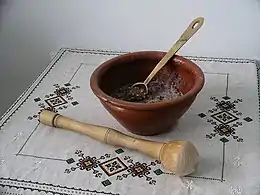 | |
| Associated cuisine | Belarusian, Russian, Ukrainian |
|---|---|
| Main ingredients | Wheatberries, poppy seeds, honey or sugar, various nuts and sometimes raisins |
Kutia or kutya (Belarusian: куцця; Russian: кутья; Ukrainian: кутя) is a ceremonial grain dish with sweet gravy traditionally served by Eastern Orthodox Christians and Byzantine Catholic Christians predominantly in Belarus, Russia and Ukraine, during the Christmas - Feast of Jordan holiday season or as part of a funeral feast. The word with a descriptor is also used to describe the eves of Christmas, New Year, and Feast of Jordan days.[1][2][3]
Etymology
The word kutia is a borrowing from the Greek language κουκκί (bean) or κόκκος (grain).[4]
Description
Ukraine
In Ukraine kutіa is one of the two essential ritual dishes at the Ukrainian Christmas Eve supper[5] (also known as Svyata vecherya). The ritual significance of kutia, as well as uzvar, is quite ancient. Ukrainian ethnographer Fedir Vovk traces the origins of these dishes to the Neolithic era. Before dinner, the kutia is placed in the icon corner ("kut") the most honorable place in the house. The pot with the kutia was to stand in this corner from Rizdvo (Christmas on December 25) to January 1, New Year's Day (formerly January 6 to the Old New Year in January 14).[6] There is also a custom of sending children with kutia to relatives, usually grandparents and godparents. After dinner, the kutia is left on the table for the whole night with spoons for the dead ancestors, "so that our relatives would have dinner and not be angry with us." The religious nature of the dish is emphasized by an ancient custom, when the head of the family approached the window or went out into the yard with a spoonful of kutia and, addressing the frost, invited him three times to take part in dinner with the family. When the frost does not appear, he is advised not to appear, not to do harm to crops, etc.: "Frost, frost, come to us to eat kutia, and if you don't come, don't come for the rye, wheat and other crops."[7][8][9]
Kutia is the first out of twelve dishes served for Svyata vecherya to be tasted.[10] The head of the family takes the first spoon of the kutia, raises it up and calls out to the souls of departed family members to join them on this night. He then tastes the kutia, and throws the rest of the spoonful up to the ceiling. In rural towns, as many kernels of grain as stick to the ceiling, there should be swarms of bees and newborn cattle in the coming year. In the same vein, if there are many poppy seeds that remain on the ceiling, there would be a chance for more hen should lay as many eggs in the coming year than usual.[11] Everyone present eats a spoonful of kutia, after which the other dishes are brought out and eaten.[12]
The main ingredients used to make traditional kutia are wheatberries, poppy seeds and honey.[13] At times, walnuts, dried fruit and raisins are added as well. Kutia is a Lenten dish and no milk or egg products can be used - since December 24 is a paramony - strict fasting and abstinence - day. There are known kutia recipes that use pearl barley or millet instead of wheatberries.[14]
Kolyvo is a Ukrainian ritual dish similar to kutia, but includes no poppy seeds. Kolyvo is served at remembrance services.
Other countries
A dish of boiled grains (usually wheat berries) mixed with honey, nuts, spices, and a few other ingredients is traditional in other countries[15] as well:
- Bulgaria – kolivo
- Greece – koliva
- Lebanon, Palestine and Jordan – ameh masslouk or snuniye
- Romania – colivă
- Russia – (also) sochivo
- Serbia – koljivo (to wit: sacrifice), or simply: žito (ie, wheat)
- Sicily – cuccìa
- Syria – sliha or burbara (for Eid il-Bur-bara, St. Barbara's Feast throughout the Middle East)
Somewhat similar, but with a different origin, and somewhat different ingredients, is the Islamic, especially Turkish, sweet dish of Ashure.
See also
References
- ↑ Білодід, Іван (ed.). "Кутя". Словник української мови в 11 томах (in Ukrainian). Київ: Наукова думка.
- ↑ Даль, Владимир (1905). Кутия (in Russian). Санкт-Петербург-Москва: Товарищества М.О. Вольф.
{{cite book}}:|work=ignored (help) - ↑ Крапіва, K, ed. (1977–1984). Куцця (in Belarusian). Менск: Беларуская Савецкая Энцыклапедыя.
{{cite book}}:|work=ignored (help) - ↑ Мельничук, О, ed. (1989). Кутя (PDF) (in Ukrainian). Vol. 3. Київ: Наукова думка.
{{cite book}}:|work=ignored (help) - ↑ "Recipe: Kutia, Star of the Ukrainian Christmas Eve Supper". Archived from the original on 2015-03-25. Retrieved 2016-12-16.
- ↑ Василь Скуратівський. Русалії. — Київ: Довіра, 1996. — С. 532—533. ISBN 966-507-028-2
- ↑ Чубинский П. П. Календарь народных обычаев и обрядов. — Київ: Музична Україна, 1993.
- ↑ Записано в селі Двірець Заславського повіту Волинської губернії.
- ↑ Хведір Вовк. Студії з української етнографії й антропології. — Прага: Український громадський видавничий фонд, б/р. — С. 183.
- ↑ Stechishin, Savella 1959, Traditional Ukrainian Cookery, Trident Press, Winnipeg
- ↑ Килимник Степан 1964. Український рік у народніх звичаях в історичному освітені Toronto
- ↑ Yakovenko, Svitlana 2013, Taste of Ukraine: Rustic Cuisine from the heart of Ukraine, Sova Books, Sydney
- ↑ Artiukh, Lidia 2001, Ukrainian Cuisine and Folk Traditions, Baltija-Druk, Kyiv
- ↑ Yakovenko, Svitlana 2016, Ukrainian Christmas Eve Supper: Traditional village recipes for Sviata Vecheria, Sova Books, Sydney
- ↑ Goldstein, Darra 2015, The Oxford Companion to Sugar and Sweets, Oxford University Press, Oxford